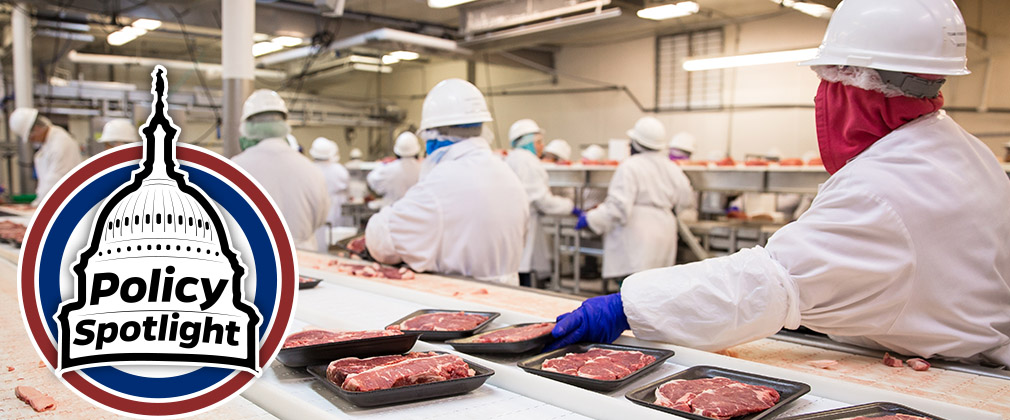Deregulating Meatpacking Line Speeds
Every quarter, Policy Spotlight addresses key policy issues in the food policy universe that we’re tracking at the Johns Hopkins Center for a Livable Future.
Slaughterhouse line speed regulations are not exactly a topic of water cooler conversations, but a move from the US Department of Agriculture (USDA) in March to allow faster line speeds at poultry and pork processing plants has garnered some media attention (Vox, Food Dive, Food Safety News). Agriculture Secretary Brooke Rollins even touted it as one of her top 5 "ag-tions" of the week in a March 21 video.
What do line workers do?
Line workers at meatpacking plants process the animal as it moves along a conveyer belt at a set speed. This may entail cutting, deboning, shaving, grinding and packaging meat on the line. These jobs are difficult and low-paying, and they are often done by immigrants.
For reference, the prior limit at swine processing plants was 1,106 heads per hour, meaning 18 per minute, or one per three seconds.
What do faster line speeds mean for workers and the meat industry?
USDA intends to allow meatpacking plants to operate faster line speeds, following up on rulemaking from the first Trump administration. It will be up to the plants to decide how much faster than the current 1,106 heads per hour will be expected from line workers. Industry groups (who have been calling for faster line speeds for years) are pleased, while worker organizations are highlighting concerns about worker health and safety.
The president of the Retail, Wholesale and Department Store Union, which represents over 15,000 poultry workers, said that "increased line speeds will hurt workers—it's not a maybe, it's a definite."
Indeed, meatpacking is dangerous work. My colleague Kelsey Crawford and I cited some of the sobering statistics in our recently published Policy and practice brief on the 2019 New Swine Inspection System, line speeds, and workers:
* Each day, 27 US line workers experience an amputation, loss of an eye, or injury requiring hospitalization. (Rimmler-Cohen, 2023)
* A study by Culp et al. (2008) found that there is at least a 1 in 3 chance of traumatic injury for swine processing line workers after just 6 months of employment.
At the same time, evidence suggests that these injuries are significantly underreported by meat companies and their employees who fear job loss, retaliation, or deportation.
Will USDA be tracking the implementation of these faster line speeds and how they impact workers?
Not exactly. This leads us to another aspect of USDA's recent announcement: They will "no longer require plants to submit redundant worker safety data, as extensive research has confirmed no direct link between processing speeds and workplace injuries." The agency is referencing two recent studies they commissioned about line speeds and worker safety, but their take is misleading at best. Those studies found that the leading driver of risk of musculoskeletal disorders was not the line speed itself, but risk was correlated with the worker’s “piece rate” – the number of animals or pieces of meat they handle per minute.
So, while Secretary Rollins is celebrating this as “cutting unnecessary red tape,” we are concerned about additional harms to people already working one of the most dangerous jobs in America—and a decrease in availability of information about those harms. As this issue evolves, we will continue to follow impacts to workers as well as comment on any future rulemaking.
